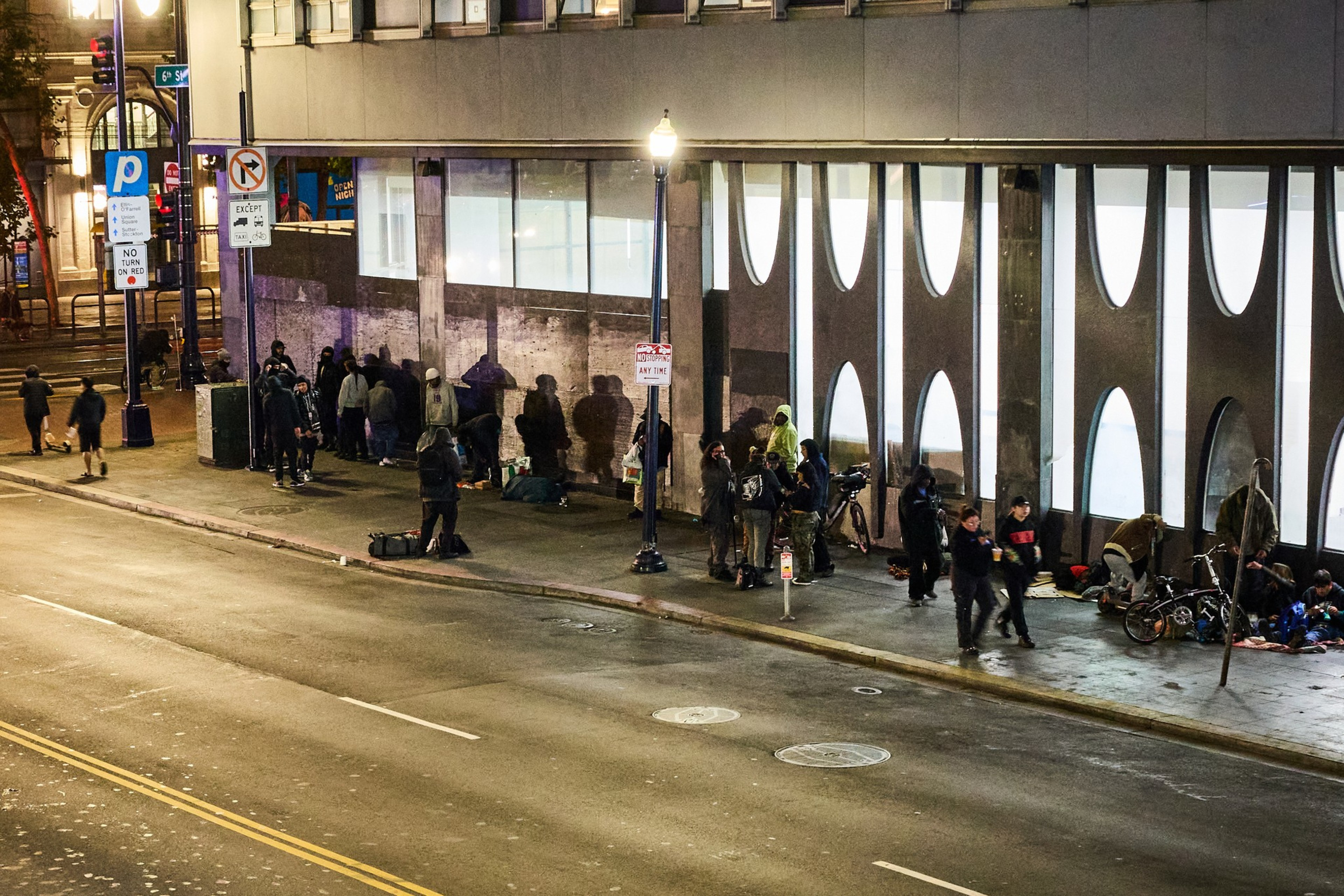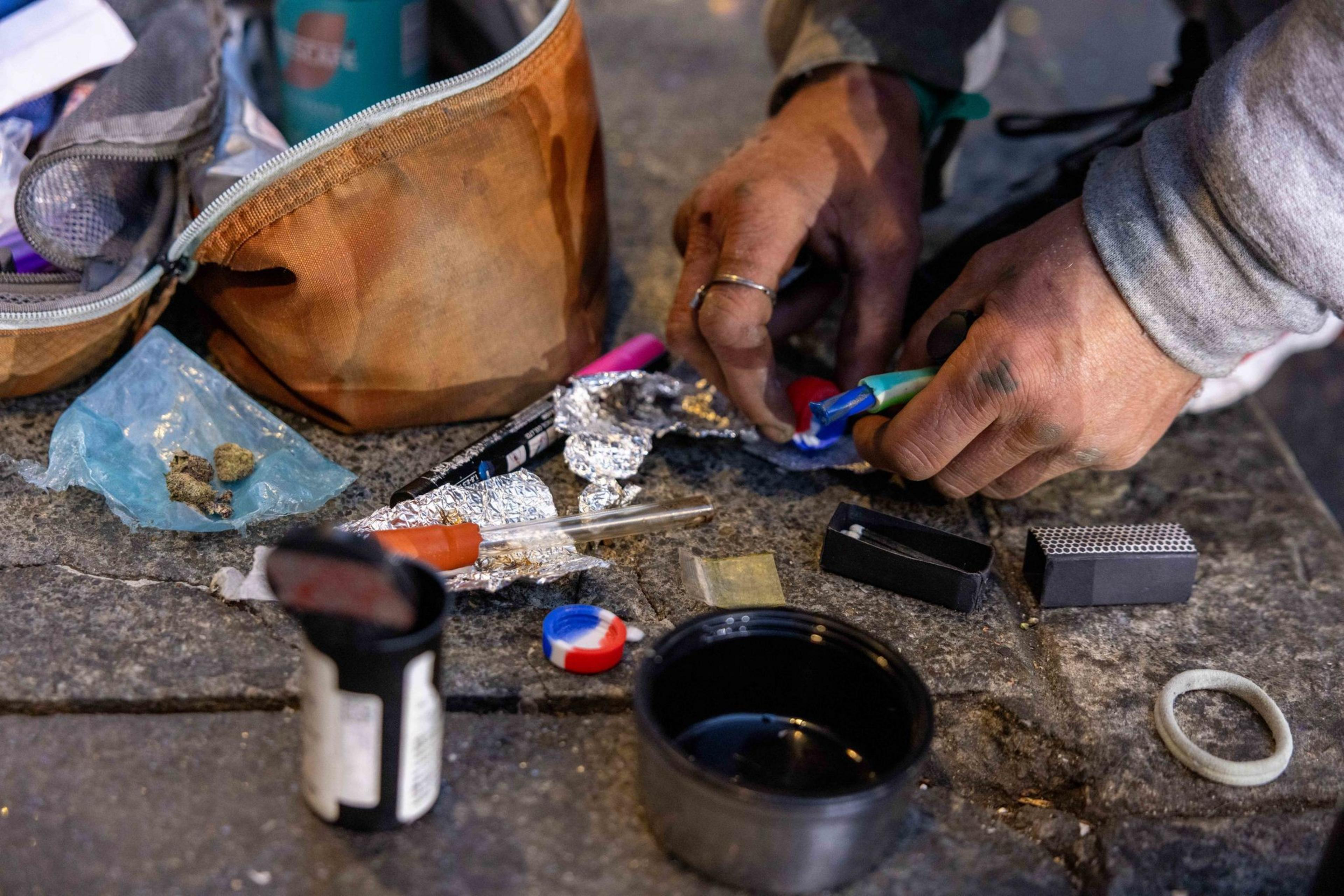It’s past San Francisco’s bedtime. The buses have mostly stopped running, and the skyline has dimmed. But many of the city’s drug dealers are just clocking in for work.
They slide ski masks over their faces as they near the infamous Sixth Street corridor, where they swap fentanyl for cash at Stevenson Street. Their customers gather around them in various states, some shouting or dancing, others slumped over, swaying listlessly, picking at their wounds or lying face down on the sidewalk, showing few signs of life.
At around 1 a.m., a police cruiser drives by, and a handful of dealers make a run for the alleyways. But most of the crowd doesn’t move.
“They’re not going to do anything,” one man assures the group as the cop slowly drives away. The nightly frenzy carries on.

Despite a highly publicized crackdown that led to more than 7,500 arrests over the past two years, San Francisco’s notorious open-air drug market lives on — just at different hours. Less than three years ago, scenes of public drug use and dealing were common throughout the day at United Nations Plaza, a few blocks from Sixth, and throughout the Tenderloin. Now those grim scenes unfold largely after midnight.
An analysis of police data by The Standard found that drug arrests decrease dramatically in the Tenderloin police district, which includes Sixth Street, once the clock strikes 12 a.m. Drug arrests peak each day between 1 p.m. and 2 p.m.; there were 165 during that one-hour timespan so far this year. By contrast, officers this year have made a total of 47 arrests between the seven-hour span of midnight to 7 a.m.
By 4 a.m., drug crime enforcement tends to stop almost entirely. During that time, officers are likely to shift their focus to other crimes, such as assault, larceny-theft, and malicious mischief, according to SFPD data. The trend is not new; since 2018, officers have focused drug enforcement efforts during daylight hours.
SFPD spokesperson Evan Sernoffsky did not directly address the drop off in drug enforcement but said in a statement that officers “conduct buy-bust operations, fugitive warrant enforcement, public drug use arrests and other operations 24 hours a day, seven days a week.”
“The drug markets are constantly changing,” Sernoffsky said. “And the SFPD is always assessing our deployment to have the maximum impact.”
For residents and businesses in SoMa and the Tenderloin, the after-dark scenes represent a failure of the city’s approach to the drug crisis, which has largely improved street conditions during the day but has been criticized for merely shuffling people around. For homeless people, the several-hour slowdown in enforcement is a chance to sleep, hustle, or get their fix without being moved or arrested.
“It’s the only safe time,” said Tana, a homeless woman who spent Wednesday night on Sixth Street. “It feels like the whole city has turned on us.”

‘Never seen a city like this’
Mayor Daniel Lurie last week took to social media (opens in new tab) with big news: Not only is total crime down 27% (opens in new tab), but San Franciscans are less likely to see tents on sidewalks than at any other time since 2018, according to the city’s quarterly tent count.
“Every day, our coordinated, multiagency teams are out in communities helping get people off the street and indoors,” Lurie said. “Thanks to that work, we are seeing real progress.”
Many streets long troubled by the twin crises of drug use and homelessness have seen improvements. And San Franciscans are increasingly optimistic about the city’s direction, polls show (opens in new tab). Lurie quickly consolidated the city’s street teams after taking office and is transforming the homeless response system to focus on mental health and addiction.

But the drop in tents doesn’t tell the whole story. As night falls in the Tenderloin and SoMa, hundreds of homeless people emerge from hiding to sleep on blankets or cardboard. Exposed to the elements and any passing stranger, some wake to find that their belongings have been stolen. Some are assaulted in their sleep. Only a few outreach workers roam the streets at that hour, and shelter beds are usually full.


“You think you’re safe at night, but you’re not,” said Derick Joyce, who has been homeless in the city for three years. “By the time you get a place to sit down, you’re worried about what happens next.”
At around 1 a.m. one day this week, a man named Burger was pushing a cart full of his belongings down Taylor Street, staking out a place to hunker down. He explained that the daytime crackdown has left him in constant survival mode.
“They just yell at people. ‘You can’t sit here. You can’t sit there,’” Burger said. “Your whole day is absorbed by moving out of their way.”

Meanwhile, late-night businesses on Sixth Street are struggling. On Monday, The Standard watched as a man in crisis walked into Supremo Pizza with his pants at his ankles, demanding that the clerk give him a quarter. Down the block, ravers taking a smoke break outside the OMG nightclub stood awkwardly between drug dealers and users.
“I have to walk my customers down the street,” said the owner of a late-night business on Sixth who asked to remain anonymous due to fear of retribution from drug dealers. “I’ve been all over the world, and I’ve never seen a city like this. It’s crazy.”

When the sun rises
As the sun rises on Sixth and Stevenson, dealers are wrapping up sales for the day. In a couple of hours, they know, police will arrive, street cleaners will powerwash the sidewalks, and drug arrests will resume.
Most leave before the cops show. But some users stay to take a few final hits.
“I’ll just wait for ’em,” Joyce says as he packs a pipe. “I’ve got nothing else to do.”



At 7 a.m., workers from the nonprofit Urban Alchemy arrive with a leaf blower and a rake to clear debris from the sidewalk. Public Works staff follow behind, blasting the streets with a hose. The cleaning process goes on for more than two hours as the streets fill with traffic and commuters pour out of nearby BART stations. The homeless people retreat to food pantries or nearby alleyways. Many drug users gather in the Mission.
Supervisor Matt Dorsey, who represents SoMa, said he is considering introducing legislation that imposes curfews on smoke shops in the neighborhood. A similar law, introduced last year in the Tenderloin, targets late-night stores that may attract illegal activity.
“I feel for the businesses that we’re punishing, because sometimes it’s no fault of their own what’s going on,” Dorsey said. “But sometimes we have to do things for the greater good of the neighborhood.”


Dorsey said he also wants to introduce a law that would codify the city’s zero-tolerance approach to public drug use — a measure that will likely draw criticism from addiction experts who warn that such enforcement can worsen health outcomes for drug users.
While some people who use drugs say the city’s enforcement measures have pushed them to seek treatment, others say the crackdown has only worsened their condition. They look back fondly on 2022, when San Francisco operated a safe consumption site and they could elect to use drugs under the relative safety of people trained to reverse overdoses.
“It went from safe usage sites to getting arrested for smoking,” Burger said. “They wanted us to use in groups, but then they started getting mad about that too.”
